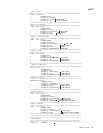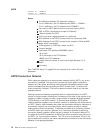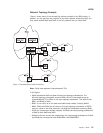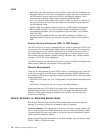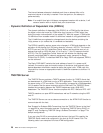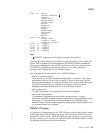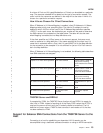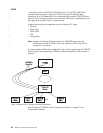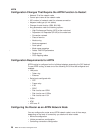CP-MSU
Control point management services unit. This message unit is generated by
CPMS and contains alert information forwarded by the router entry point.
CPMS passes CP-MSU message units to MDS.
MDS-MU
Multiple-domain support message unit. This message unit is generated by
MDS. It encapsulates the CP-MSU for transport between nodes.
SNMP Capabilities for APPN MIBs
An operator or application at an SNMP network management station can query
objects in the APPN MIBs (using the SNMP get and get_next commands) to
retrieve APPN status information and node statistics. A subset of APPN MIB objects
can be modified using the SNMP set command. The APPN MIBs can be accessed
only using SNMP.
Topology Database Garbage Collection
Information flows between APPN NNs to inform the NNs about network resources.
Each NN keeps a topology database consisting of the names and characteristics of
those resources. When a resource is eliminated from the network, it can also be
deleted from each NN topology database. When a NN detects that a resource in its
topology database is obsolete, the node will broadcast information stating that the
resource should be garbage-collected. If NNs receiving this information support
Enhanced Garbage Collection, they should delete that resource from their topology
database. The record is not actually garbage-collected until the next garbage
collection cycle. A NN examines each resource in its topology database once a day.
Configurable Held Alert Queue
The configurable held alert queue function allows you to configure the size of the
held alert queue. If a focal point is not available, the held alert queue saves APPN
alerts. When a focal point becomes available, the held alerts are sent. If more alerts
arrive than can be held, the oldest alerts are discarded.
Note: If you configure a large value for the Held Alert Queue Size, the extra
memory should be accounted for. You can do this by letting the tuning
algorithm automatically calculate the Maximum Shared Memory value. See
“APPN Node Tuning” on page 38 for additional information about the node
tuning algorithm.
Implicit Focal Point
A focal point is a node with centralized management responsibility. The managing
node can contact the managed node (router) and establish a management session.
The managing node is then an explicit focal point. When the name of the managing
node is configured at the router and the router can initiate a management session,
the managing node is an implicit focal point. You can configure a single, primary
implicit focal point with up to eight backup implicit focal points, where each focal
point is a fully qualified network name. The router will attempt to contact each focal
point in order until a successful management session is established.
If the management session is with a backup implicit focal point, the device will
periodically attempt to reestablish its session with the primary implicit focal point.
APPN
Chapter 1. APPN 19



